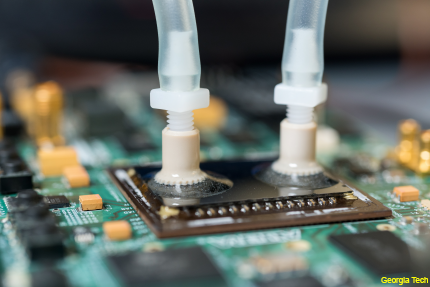Water-cooled chip a breakthrough for processing power
Researchers at Georgia Tech, funded by DARPA, may have opened the door for a new breed of electronics.

Researchers send de-ionized water within a few hundred microns of the transistors.
Pentagon-funded researchers at the Georgia Institute of Technology have reported a breakthrough in overcoming one of the prime obstacles to increased processing power: heat.
Their innovative design involves sending liquid coolant—in the form of de-ionized water—through microfluidic passages within a few hundred microns of the transistors, allowing chips to operate at temperatures more than 60 percent lower than air-cooled chips, according to a Georgia Tech announcement.
Not only will the design allow for more dense and powerful integrated electronics, it also will allow for smaller electronics, because they would no longer require heat sinks or cooling fans.
“We believe we have eliminated one of the major barriers to building high-performance systems that are more compact and energy efficient,” said Muhannad Bakir, an associate professor and ON Semiconductor Junior Professor in Georgia Tech’s School of Electrical and Computer Engineering. “We have eliminated the heat sink atop the silicon die by moving liquid cooling just a few hundred microns away from the transistors. We believe that reliably integrating microfluidic cooling directly on the silicon will be a disruptive technology for a new generation of electronics.”
The research, which is supported by the Defense Advanced Research Projects Agency, is believed to be the first time anyone has successfully used liquid cooling on a high-performance CMOS chip and. Along with more processing power, it could also extend the life of devices using the chip, Georgia Tech said.
Researchers worked with 28-nanometer field-programmable gate array devices made by Altera, removing the heat sink and heat-spreading materials, and cutting microfluidic passages about 100 microns in diameter (about four-thousands of an inch) onto the back of the FPGAs. They then covered the passages with a layer of silicon and added tubes to carry the water.
With a custom-built processor architecture by Altera, researchers conducted a series of tests, including a demonstration at DARPA headquarters. The result: With an initial water temperature of 20 degrees Celsius (68 degrees Fahrenheit), the liquid-cooled FPGA ran at lower than 24 degrees C. Meanwhile, an air-cooled device ran at 60 degrees C, the researchers said.
“We have created a real electronic platform to evaluate the benefits of liquid cooling versus air cooling,” Bakir said. “This may open the door to stacking multiple chips, potentially multiple FPGA chips or FPGA chips with other chips that are high in power consumption. We are seeing a significant reduction in the temperature of these liquid-cooled chips.”
Researchers used FPGAs because they are common of defense and other segments, and because they allow for testing different circuit designs, but Bakir said the same approach could be used for cooling CPUs, GPUs and other devices.




